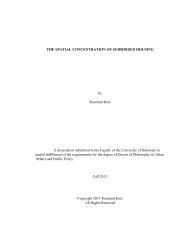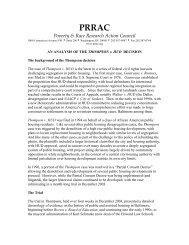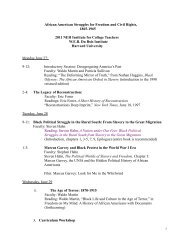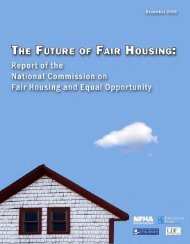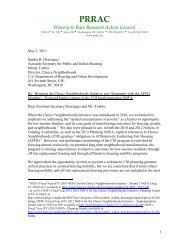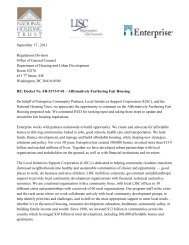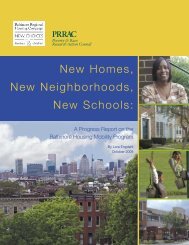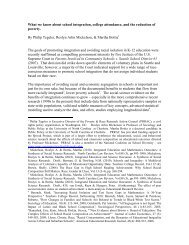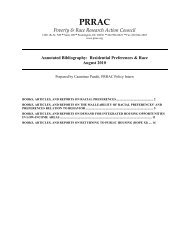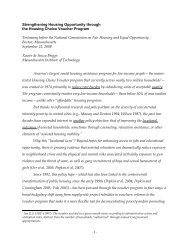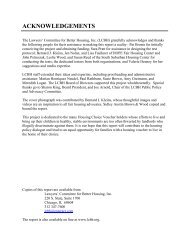Annotated Bibliography of Housing Mobility Research 2006-2010
Annotated Bibliography of Housing Mobility Research 2006-2010
Annotated Bibliography of Housing Mobility Research 2006-2010
You also want an ePaper? Increase the reach of your titles
YUMPU automatically turns print PDFs into web optimized ePapers that Google loves.
Bennett, Larry, Janet L. Smith & Patricia Wright (eds.), Where Are Poor People to Live:<br />
Transforming Public <strong>Housing</strong> Communities. M.E. Sharpe (<strong>2006</strong>)<br />
Summary: Focusing on Chicago, this book shows how major shifts in federal policy are spurring local public<br />
housing authorities to demolish their highrise, lowincome developments and replace them with<br />
affordable lowrise, mixed income communities. The editors and chapter authors express a<br />
concern that proponents <strong>of</strong> public housing restructuring give little attention to the social, political,<br />
and economic risks involved in the current campaign to remake public housing. The first section<br />
<strong>of</strong> the book discusses the national and local contexts for public housing transformation; the second<br />
section focuses on the Chicago <strong>Housing</strong> Authority’s Plan for Transformation and its impact on<br />
public housing residents; finally, the third section discusses policy implications. Chapter authors<br />
include: Yan Zhang, Gretchen Weismann, Susan J. Popkin, Richard M. Wheelock, Carol Steele,<br />
William P. Wilen, Rajesh D. Nayak, and Wendy L. Stasell.<br />
Bonastia, Christopher, Knocking on The Door: The Federal Government’s Attempt to<br />
Desegregate the Suburbs. Princeton, NJ: Princeton University Press (<strong>2006</strong>)<br />
Summary: This book provides an indepth look at the federal involvement in residential segregation from the<br />
Reconstruction period to the present. Details <strong>of</strong> the events from the period <strong>of</strong> 1968 to 1973 provide<br />
an explanation <strong>of</strong> the US Department <strong>of</strong> <strong>Housing</strong> and Urban Developments’ plans for<br />
desegregation, until President Nixon’s decision to freeze federal housing funds in January 1973.<br />
The period was marked by new legislative protections against housing discrimination,<br />
unprecedented federal involvement in housing construction, and frequent judicial backing for the<br />
actions <strong>of</strong> civil rights agencies. By comparing housing desegregation policies to civil rights<br />
enforcement in employment and education, the author <strong>of</strong>fers an account <strong>of</strong> why civil rights<br />
policies diverge so sharply in their ambition and effectiveness.<br />
BrowneDianis, Judith & Anita Sinha, Economics and Development: The Cost <strong>of</strong> Hurricane<br />
Katrina: Exiling the Poor: The Clash <strong>of</strong> Redevelopment and Fair <strong>Housing</strong> in PostKatrina New<br />
Orleans, 51 HOWARD LAW JOURNAL 481 (2008)<br />
Summary: Examines the government's postKatrina actions with respect to New Orleans public housing and<br />
discusses how the plan for public housing constitutes an eradication <strong>of</strong> the buildings and families<br />
who lived in them, demonstrating that the "opportunity" created by the storm is not for the city's<br />
lowincome residents <strong>of</strong> color. It also addresses how the government's plans for New Orleans'<br />
public housing violate Title VIII <strong>of</strong> the Civil Rights Act <strong>of</strong> 1968 the Fair <strong>Housing</strong> Act. Argues<br />
that, in the case <strong>of</strong> New Orleans as well as nationwide, the mere issuance <strong>of</strong> vouchers to public<br />
housing residents displaced by HUD's redevelopment plans cannot meet HUD's obligation to<br />
affirmatively further fair housing, because vouchers simply do not <strong>of</strong>fer the housing opportunities<br />
the statute was intended to create for African Americans.<br />
Buron, Larry, Diane K. Levy & Megan Gallagher, “<strong>Housing</strong> Choice Vouchers: How HOPE VI<br />
Families Fared in the Private Market,” Urban Institute (2007)<br />
Highlights:<br />
Abstract:<br />
· HOPE VI residents who relocated with a voucher were more likely to be younger, female,<br />
living with children, and employed, as compared to residents who relocated to public housing<br />
· 47% <strong>of</strong> voucher holders moved to neighborhoods with less than 20% poverty, only 11%<br />
remained in extremely highpoverty neighborhoods<br />
· Voucher holders report improved mental health<br />
Most former HOPE VI residents received <strong>Housing</strong> Choice Vouchers to relocate. Compared with<br />
those who moved to traditional public housing developments, voucherholders are living in<br />
22



